The Olympic Games were invented by the ancient Greeks in 776 BCE. The first Games debuted in Olympia, Greece at a sanctuary site for the Greek deities.
A foot race, known as stadion, was the first and only event at the Olympics until 724 BCE. Three more foot races, several combat sports, and equestrian events comprised the ancient Olympic sports.
Most of these sports are still in the Games today in a modified form.
9. Hoplite Race (Hoplitodromos)
Year Introduced: 520 BCE
Still Played Today: No
Special Equipment Used: Hoplite armor: a helmet, shield, and grieves; event took place at a stadion track
Number of Competitors: Unknown, possibly up to 20 like all stadion events
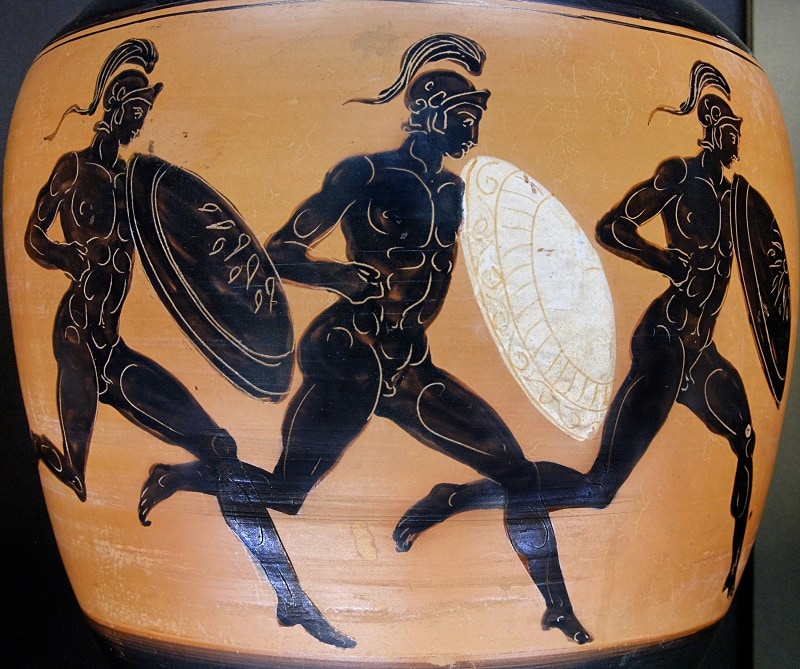
The hoplite race, which was called hoplitodromos by the Greeks, was the fourth and final foot race added to the ancient Olympics. Unlike the other foot races, which were done in the nude, the hoplite race required athletes to wear armor (which could weigh over 50 pounds) consisting of a helmet, shield, and greaves — the greaves were removed in the mid 5th century BCE because they impeded leg movement.
This race tested athlete’s muscular strength and endurance. It typically only required two lengths of the stadion track (about 192 m (629.9 ft)), but at Nemea it was four stadia and at Platea it was 15. Like the other foot races that required more than one stadion, hoplite racers were required to run around a pole known as the kampter at the end of each lap.
8. Pankration
Year Introduced: 648 BCE
Still Played Today: No
Special Equipment Used: None
Number of Competitors: Two in each match; most events had four rounds with sixteen athletes
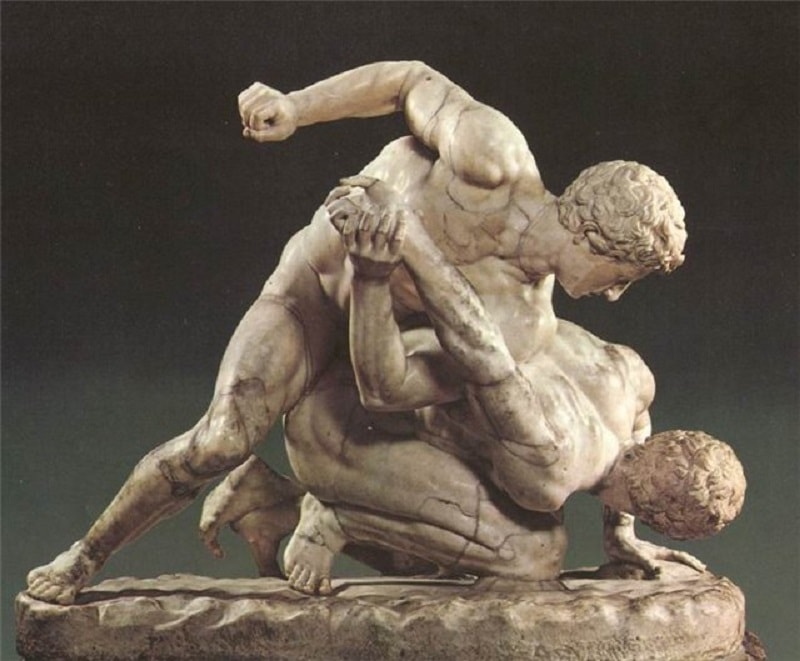
Pankration was the final combat sport added to the ancient Olympic Games. Of the three combat sports (the other two were wrestling and boxing), pankration was the most dangerous. It was a violent, bare-handed submission sport that had very little restrictions.
This brutality was illustrated by the event’s name, pankratos, which literally means “all of power”, from pan meaning “all” and kratos, which meant “strength, might, power”.
According to Greek mythology, pankratos was invented by the heroes Heracles and Theseus, who used wrestling and boxing methods to defeat their opponents. All boxing and wrestling techniques, as well as kicking, holds, locks, and chokes on the ground were acceptable. The only restricted actions were biting and gouging your opponent’s eyes out.
Pankration was so dangerous that several athletes died. Although the sport was violent, it was popular for centuries and even crossed over into Roman culture.
7. Four-Horse Chariot Racing (Tethrippon)
Year Introduced: 680 BCE
Still Played Today: No
Special Equipment Used: Chariots and horses; event took place at the Hippodrome
Number of Competitors: Unknown
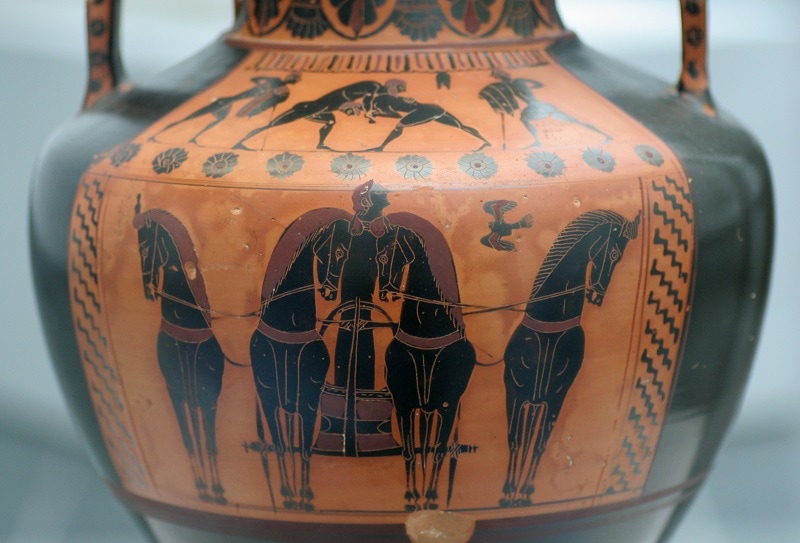
The four-horse chariot race, called tethrippon by the Greeks, was the first equestrian event added to the Olympic Games in 680 BCE. To accommodate for the new event, the Olympics were expanded from a one-day to a two-day event.
The chariot events took place at the hippodrome, which was a wide, flat, open area where the starting and finishing line was defined by a pole. The track also had a second smaller pole, called the nyssa, which was a difficult turn that caused many accidents.
It is believed that the tethtrippon consisted of 12 laps because the poet Pindar called the event dodekadromon — the laps equaled about 14 km (8.6992 mi). Very little is known about the actual rules of any of the equestrian events, but historians know for sure that competitors were not allowed to swerve in front other racers unless he was way ahead of those behind him.
6. Boxing (Pygmachia)
Year Introduced: 688 BCE
Still Played Today: Yes
Special Equipment Used: Ox hide leather wraps called himantes and oxys
Number of Competitors: Two in each match
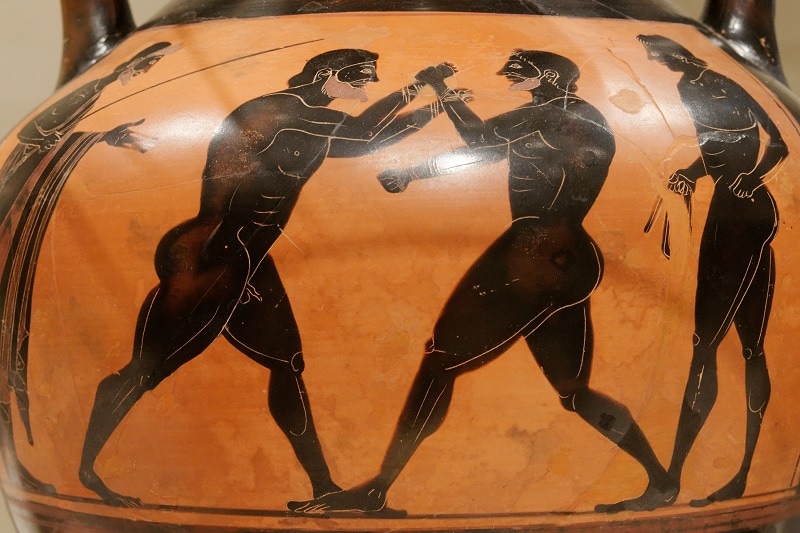
Boxing is not only one of the oldest Olympic sports, but it is also one of the oldest contact sports overall. Ancient Greek boxing, which was called pygmachia, was added to the Games in 688 BCE and the second combat sport. After it was introduced, boxing was present at every ancient Olympiad and was highly popular in Greek culture for over one thousand years.
Unlike today’s boxing, which has more rules to ensure athletes’ safety, pygmachia was very rough. Initially fighters wore ox hide leather wraps called himantes around their hands, knuckles, and wrists, but the gloves eventually became more lethal. Boxers started using sharp-edged gloves called oxys, which occasionally led to deaths during matches.
These ancient boxing matches only lasted for one round and the goal was to either knock your opponent unconscious or get them to submit.
5. Pentathlon (Discus Toss, Javelin Throw, Long Jump, Stadion, and Wrestling)
Year Introduced: 708 BCE
Still Played Today: No, but the individual events (discus, javelin, and long jump) still exist and there is the men’s decathlon and women’s heptathlon
Special Equipment Used: Discus, javelins, halteres (which were similar to modern dumbbells and used for the long jump), and stadion track
Number of Competitors: Unknown
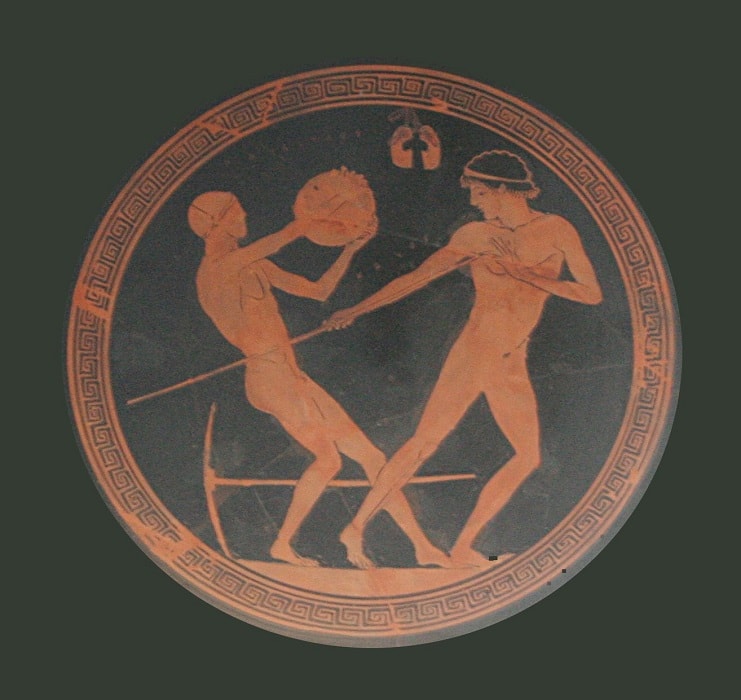
The pentathlon was the first multi-event competition added to the Olympics, which debuted with the separate wrestling event in 708 BCE. It consisted of five events: discus toss, javelin throw, long jump, stadion (foot race), and wrestling — discus, javelin, and long jump were not held as individual events at the early Games.
No one knows the exact order of the events of the pentathlon, but they were all held on the same day and they always ended with wrestling.
It is also unclear how the winner of the pentathlon was chosen, but the foremost theory is that the top athletes selected for the final wrestling tournaments were the winners from the four other events. There is also evidence to support that an overall winner was chosen if they won at any three events.
Pentathletes were considered to be the most beautiful and aesthetically pleasing Olympic athletes because they had to be well-rounded to compete in so many different events.
4. Wrestling (Palé)
Year Introduced: 708 BCE
Still Played Today: Yes
Special Equipment Used: None
Number of Competitors: Two in each match
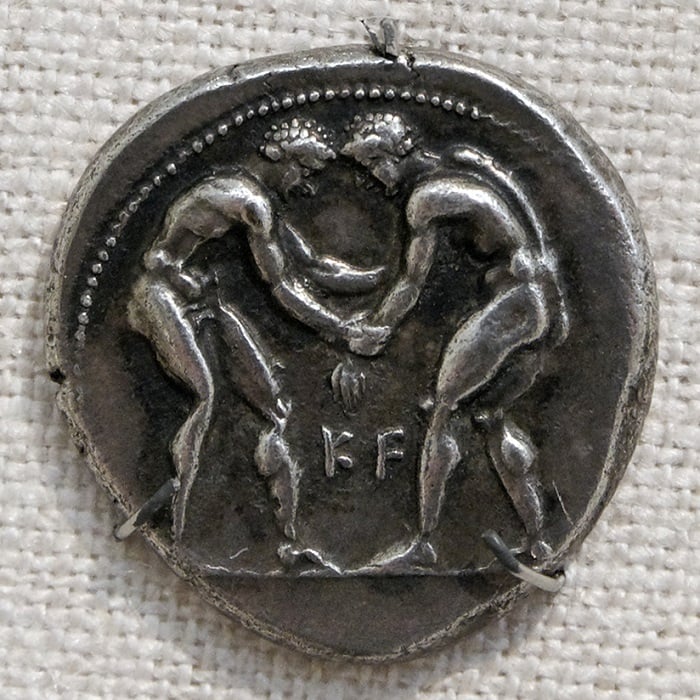
In 708 BCE, two new events were added to the Olympic Games, wrestling (palé) and the pentathlon. Wrestling was the first combat sport added to Games and was considered the safest of the three Greek combat sports (boxing and pankration were added later). Wrestling was also included as one of the five events in the pentathlon.
The Greeks employed two methods of wrestling: upright wrestling (orthe palé), which took place in the sand pit, and ground wrestling, which was done on wet sand (kato palé). There is some disagreement over whether or not ground wrestling took place at the Games. However, there are records that suggest that the athletes started upright then took the match to the ground if a fall was not scored after a sweep or throw.
3. Long Distance Running (Dolichos)
Year Introduced: 720 BCE
Still Played Today: Yes closest equivalent is 5000 m race
Special Equipment Used: None, but event took place in special building called a stadion
Number of Competitors: Up to 20
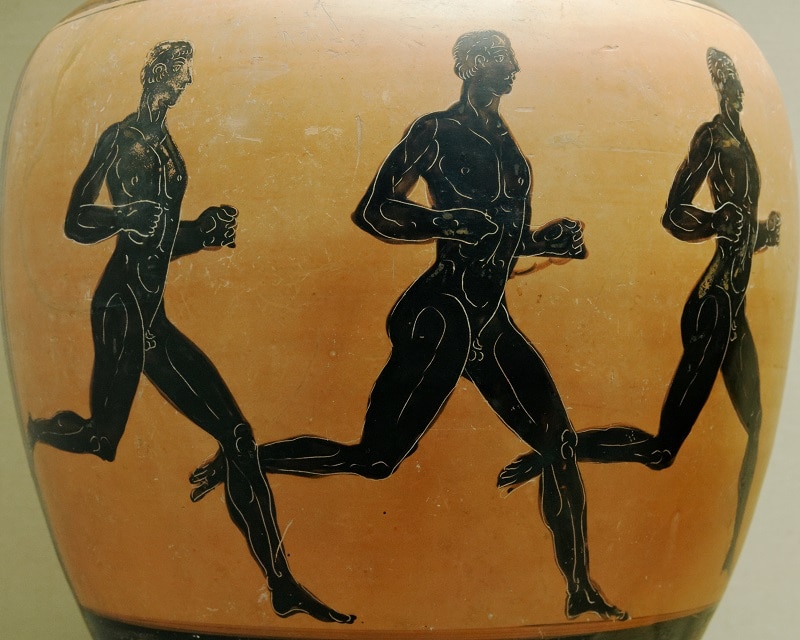
The dolichos was the third running event added to the Olympics in 720 BCE. Like the other foot races, the dolichos took place in a stadion. Though the distance of the race varied, it was typically about 18 to 24 laps, which was about 3,465 m (11,368.11 ft) to 4,620 m (15,157.48 ft). Just like in the diaulos race, competitors had to loop around a pole called a kampter at the end of each lap to continue the race.
Since the dolichos was a long distance race, the runners did not exert a lot of effort in the early laps of the race and moved a little faster than walking speed. They only picked up the pace in the last laps and sprinted to the finish. The dolichos wasn’t a main event and was added to pad out the Olympic Games and provide more entertainment for the audience.
2. Double-Stade Foot Race (Diaulos)
Year Introduced: 724 BCE
Still Played Today: Yes as the 400 m race
Special Equipment Used: None, but event took place in special building called a stadion
Number of Competitors: Up to 20
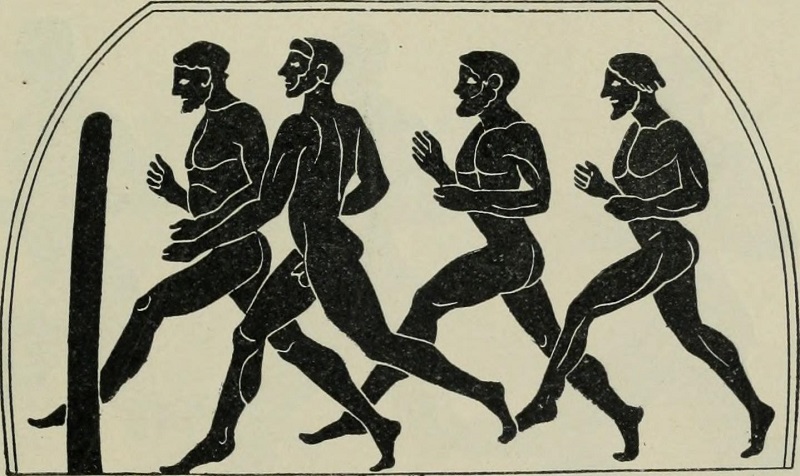
The diaulos or double-stade foot race was the second event added to Olympic Games in 724 BCE. It was identical to the first Olympic running event stadion, but was twice the length. Athletes would sprint to the end of the stadion track and sprint back to the starting line.
For the diaulos a pole called a kampter was planted in the ground, which athletes needed to loop around to complete the race. Historians are not sure whether or not each competitor had their own kampter or if they had to all loop around the same one.
According to Philostratus (ancient Greek author), who wrote a book about Greek athletics, diaulos runners needed more endurance and had to be built stronger than stadion runners.
1. Running (Stadion)
Year Introduced: 776 BCE
Still Played Today: Yes as the 200 m race
Special Equipment Used: None, but event took place in special building called a stadion
Number of Competitors: Up to 20

The running race known as stadion or stade is the oldest Olympic Sport in the world. It was the only event at the very first Olympics in 776 BCE and remained the sole event at the Games until 724 BCE.
The length of the race was 600 Greek feet, but this was not a standardized unit so stadions often varied in length. The original stadion in Olympia is about 192 m (629.9 ft).
Stadion was named for the building in took place in, which was also called stadion. This word eventually became stadium in Latin and English and is the reason why we call sports arenas stadiums.
The stadion race was the most prestigious event in the ancient Olympics, even after other sports were introduced. The winner of the race was considered the victor of the entire Games and each Olympiad was named after the winner.
OTHER POSTS YOU MAY BE INTERESTED IN











